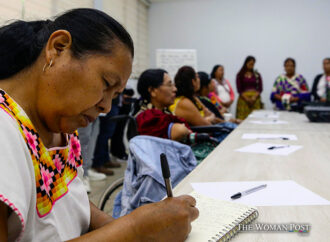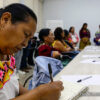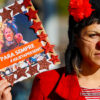The psychologist, Viviana Quintero, describes the dangers to which children and adolescents are exposed on the Internet.
The psychologist, Viviana Quintero, describes the dangers to which children and adolescents are exposed on the Internet.
The risks that minor runs of being sexually violated online begin with the mistake that many parents make of providing their children very early access to technological devices without establishing guidelines for proper and supervised use.
The psychologist, Viviana Quintero, describes the dangers to which children and adolescents are exposed on the Internet.
Viviana Quintero is a psychologist and for 12 years she has been working on the issue of cyberbullying which, in Colombia, is not classified as a crime, even though “it is given other names in the Penal Code (in articles 218 and 219A) such as sexual exploitation of boys, girls, and adolescents or pornography with persons under 18 years of age ”.
The victims of cyberbullying through social networks and digital platforms are mostly female. Statistics show that 83% of the cases correspond to them, while 17% are reported for children.
The aggressors have an inventory of resources to deceive, which include impersonation (they can pose as characters that minors admire) or offer emotional support to gain the trust of the minor. “Frequently there are cases of open seduction in which the aggressor presents himself to the victim -who could be 12 years old, for example- with his real age and identity and usually falls in love with her with sweet words. The girl is flattered to have caught the attention of an older man and plays along."
The psychologist explains that in these scenarios a huge power difference is established because the brain of a child or adolescent does not yet function like that of an adult who, consequently, resorts to abuse strategies, aware of their ability to influence.
Profiles
Sexual abusers come in different faces and are moved by a variety of purposes. Some are moved by the desire to extract graphic material from their victims to market. Pedophiles are interested in establishing intimate relationships with minors and there are others who are simply turned on by virtual sexual exchanges.
Many aggressors of this type plan their movements on the Internet, study the child or adolescent, scrutinize their publications, and come up with knowledge that allows them to easily break the vulnerability of the minor who may feel lonely, misunderstood, isolated, depressed, or sad.
Sexual aggressors on the Internet are not frequent, but, according to the psychologist consulted by The Woman Post, Viviana Quintero, “if we find some who seek contact to pass it on to a man or those who instrumentalize children, that is, caregivers or mothers who have the children in their care and use them to generate sexual content and sell it or facilitate access to the victim for others”.
The sexual offender is characterized by some behavioral conditions that are pertinent to know: “He can pretend that the minor is in control of what happens between him and the child and usually manifests himself with expressions such as 'we will only do what you want'. They could give gifts -a token for games or links for downloads-, invites the child to speak through not so common networks, asks many questions to get to know the child and his environment, says phrases to which the child does not know how to answer such as "what do you feel when do you kiss? Or have you ever been turned on?", he frequently manipulates the minor with warnings that try to hide the encounters and threatens her by saying "if you comment that you know me they will punish you and we will not see each other anymore."Some openly show sexual content and ask for personal encounters”, warns the specialist.
Sexting
Quintero explains that the term is derived from the English words "sexual testing" and could be translated as "a practice that involves sharing sexual content through digital platforms. Once the exchange of videos or photos takes place, it seems to be clear that, who provides the material, would be guaranteeing that the other dispose of it as they see fit and this includes distribution or sale. Although the abuser can argue that there was consent, no one would have the right to expose the privacy of another, and, if it is a minor, we are talking about a crime contemplated in the Colombian Penal Code".
Also read: Motivating children with magic during COVID-19 pandemic
Another frequent scenario that affects minors occurs when any of them decide to practice sexting with someone their age who could freely dispose of the graphic material provided to show it with the intention of harming: “Often the person who is socially singled out is the one who took the photos or videos of himself and shared them and not who did the socialization of them. There are disqualifications and accusations that, of course, seriously harm the boy, girl or adolescent who made the wrong decision to share intimate graphic material”.
The specialist adds that there are cases in which minors are used by criminal gangs to obtain graphic material of a sexual nature from people their age or younger, which will then be sold online.
Vulnerable children
The risks that minor runs of being sexually violated on the Internet, begin with the mistake that many parents make of providing their children very early access to technological devices without establishing clear guidelines about their appropriate use and without mentioning protection measures. In a high percentage, there are children and adolescents who do not trust their parents or caregivers or have an insecure attachment to them: "These are victims of easy access for an aggressor or could incur in sexting practices to feel appreciated."
We often overlook factors that make it easy for a sex offender to reach a minor. He does know the flatways to make his job easy! Viviana Quintero recommends opening your eyes to these realities:
– Social networks should not be used by children under 13 years of age because their brain development does not allow them to have criteria to interact virtually in a safe way: “They do not recognize what is true of what is not, nor are they capable of noticing the intentionality in the actions of the people who approach them or the reliability of the content that may appear online ”.
– Access to social networks is not a merely technical matter, if it were, it would be enough to have software that restricts its use: “In a high percentage, minors who approach a social network tell lies about themselves. Consequently, it is easy for them to reveal information, expose their emotions and their privacy”.
– Society, which should act to protect children, unfortunately usually manifests itself by making comments that victimize the child or adolescent: “We can find vulgar expressions depending on the physical appearance of the minor or they reproach him for being in spaces that are not for him . In short, the victims are rejected ”. For all these reasons children need to be protected.
International organizations
In 2012, Quintero recalls, the UN became interested in online harassment and violence, sexual exploitation, and virtual pornography and appointed a rapporteur to investigate these issues. Then, two years later, another rapporteur appears for more specialized topics such as cyberbullying and bullying.
The result was two global reports that delve into these issues and, later, ECLAC makes a call based on the digital rights of children and adolescents: "It is not only about restricting access, but about protecting them."
The UK generates a £ 50 million fund to prevent sexual violence against children and adolescents on the Internet. Other international organizations join the purpose, which is why, worldwide, a collective effort began to be generated in order to counteract the virtual violence that targets children and adolescents.
Although these could be classified as macro efforts, the issue demands micro solutions that begin in homes where parents must watch over their children when they use technological devices and avoid giving away technology at an early age. Quintero emphasizes that “digital environments are not safe spaces for children and therefore strict rules and limits imposed by parents are required. The child or adolescent, by themselves, will not regulate their behavior in digital environments and that is why the intervention of an adult is needed”.
Other recommendations
– It is pertinent that parents talk about sexuality with their children: "When the topic is avoided in family conversations, the one who will respond to children's concerns will be the Internet."
– Parents should promote trust between themselves and their children: "No matter what a child or adolescent does, they should always feel that they can talk about anything with their mother and father."
– Pornography is an issue that should be addressed as a family: “We can explain it by telling the child that it is about images or videos in which adults appear naked. The advice should be extended to the recommendation to close the screen when, by chance, the child could come across this type of material and discuss the matter with an adult they trust ”.
– The technology has parental controls and it is important to activate them.
– The child should not be afraid to tell their parents if an adult says things that make them uncomfortable, touches them, or shows them graphic material alluding to sexual practices or, simply, is uncomfortable in their presence.
Risk situations related to cyberbullying in Colombia can be reported through line 141 of the Colombian Institute of Family Welfare; line 122 of the Prosecutor's Office or the ADENUNCIAR app, also of the Prosecutor's Office, and at www.teprotejo.org managed by civil society that channels the reports received to the authorities if they deem it necessary.
The psychologist Viviana Quintero can be contacted through @vivianaqdigital on Instagram and Twitter
























Leave a Comment
Your email address will not be published. Required fields are marked with *